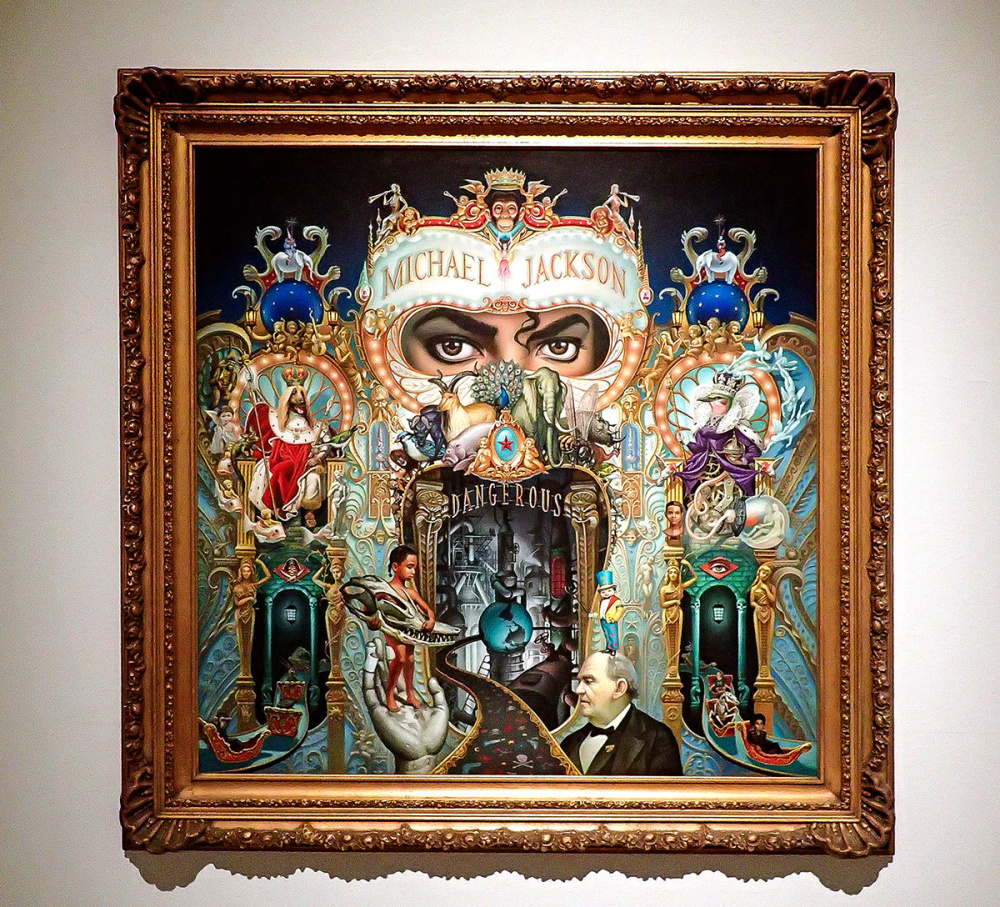
The Original painting from Mark Ryden of the Michael Jackson’s Dangerous Album is currently on display at the Centro de Arte Contemporaneo de Malaga in Spain!
The Exhibition includes various artistry from Mark Ryden as well as the so famous [for Michael Jackson Fans] painting of the album cover!
The Exhibition has been running since December 16 and will end on March 5, 2017!
Here a little description of the Exhibition for those interested:
In this large retrospective exhibition, Cámara de las Maravillas, it will be possible to view works from all of his series, many of which prove to be contemplative (The Snow Yak Show) or disconcerting (Blood), while others are extravagant (The Meat Show) or brimming with nature (The Tree Show), while several are especially laden with iconography and symbolism (The Gay 90’s) and others are devoted to conversations amongst his unique rabbits and bees (Bunnies & Bees). All are riddled with a strong, unintentionally provocative feeling.
Mark Ryden has created a unique style of his own which blurs the traditional borders in art, beginning a new genre of painting known as “Pop Surrealism.” Ryden’s work fluctuates between the cryptic and the beautiful, tracing a fine line between the feelings born from memory and iconographies which may seem disturbing upon first analysis. Seduced by its infinitely detailed and painstakingly enamelled surfaces, viewers of his work confront a juxtaposition of childhood innocence and the soul’s mysterious hidden corners, from a strangely classical and traditional brushstroke, so carefully placed that Ryden is forced to use a magnifying glass to make his works.
The magical realism introduced in Mark Ryden’s art has roots in surrealism and even Dadaism, without any prejudice. In Apology #58, 2006, Cernunnos #67, 2006, The Debutante, 1998, Euglena #111, 2014, Porcelain Meat Cart (pink) #7/9 2012, The Parlor – Allegory of Magic, Quintessence, and Divine Mystery #101, 2012, Self Portrait as a Dodecahedron, 2015 and countless other works, Ryden reproduces this Dadaist eye. On infinite occasions, the artist paints this symbol portrayed so often by Johannes Theodor, Picabia and Man Ray, as well as Apollinaire’s “caligrams.”
Mark Ryden’s world is a place infused with bittersweet nostalgia, tinged with macabre darkness, in which complex psychological elements lie beneath a surface comprised of cultural clichés. Coexisting within it we can find President Lincoln, Jesus Christ, Buddha, Santa Claus and the devil. Ryden’s work highlights the mysterious facets of the classical, juxtaposed with eerie childlike characters who have huge eyes which are pensive but expressive. Without a doubt, this is the feature of his work which most draws attention: his distant heroines, inaccessible but vulnerable, capturing viewers’ glances with the same uncanny, mysterious expressiveness as the Mona Lisa, the Girl with a Pearl Earring, Las Meninas, the Odalisque and Olympia. These bleak yet sweet protagonists seem to read the thoughts of the people who observe them. Viewers may at first reject such daring audacity, but eventually they become trapped, unable to turn their eyes away from such convincing, unwavering stares. It is impossible to determine their age or say whether they are girls or teens, inhabitants of a space in limbo. They are actually incarnations of the soul.
Amongst his most commonly used iconography, you will also find the figure of the American President Lincoln, represented as a hero who frees the slaves. In Ryden’s work, Lincoln is more of an idol than a human being. Mark Ryden is more interested by his aura and his status as a superhero. Exposed to the image of Lincoln from a very early age in the United States, there is something quite special about this iconic image for Ryden, because it has nothing to do with any other, like President Washington. To the artist, because he was one of the first people to be photographed in the world, there is something strange and awe-inspiring in Lincoln’s face and the image it conveys in his photographs. In the end, Lincoln was considered much more than another president of the United States. He was “beatified.” For Ryden, perhaps Lincoln was turned into a martyr by the sin of slavery. This can be appreciated perfectly in his work Grotto of the Old Mass, 2008, in which Lincoln appears before a girl inside of a cave, as if he were the Virgin of Lourdes.
In analytical psychology, also known as the psychology of complexes or Carl Gustav Jung’s deep psychology, “anima” is the feminine aspect of masculine subconscious (while “animus” is the opposite, the masculine lying within the feminine subconscious). His paintings are works of research on matters of philosophy, about the problems of mortality and the occult. Mark Ryden conceives his work in the way philosopher and essayist Walter Benjamin viewed art, as a vehicle for transforming the spirit. The artist uses his way of seeing to achieve this: his eyes are a window onto the soul.
When contemplating the artist’s work, viewers travel into a strange, imaginary world which offers up the delicious charm of the irrational upon observing Mark Ryden’s frightful but oddly appealing world. His work produces what Edmund Burke describes as a “terror for the sublime,” the oddness of his paintings spurring a delectable chill. His works may seem simple, but afterwards they continue growing towards a “horror vacui” in which an overwhelming density of kitsch elements impregnates every piece. The artist sees nothing negative about the kitsch. Quite to the contrary, it delights him. Different aspects of American kitsch have played an important role for other artists who have already had their work exhibited at CAC Málaga, including Paul McCarthy and Yoshitomo Nara.
His technique is precise, meticulous and attentive to detail. With pure, clean colours, they lie beyond the realm of any specific time or place, because few references link them to contemporary life. The greatest trap set by nostalgia is oversensitivity, and Mark Ryden manages to avoid this because of his eerie subject matter and esoteric juxtapositions. One example of this is the work Allegory of the Four Elements (#59), 2006, in which four girls drink tea in what seems to be a tame scene of peaceful normality. This is the first impression that viewers experience, but they soon notice that they have been invited to a bizarre meeting in which the girls, donning different colours, symbols of alchemy on their chests and animals atop their heads, are not just four innocent girls, but actually air (white/bird), earth (red/deer), fire (yellow/squirrel) and water (green/fish). Moreover, three eerie babies sitting in a bird’s nest bear the initials C, F and M (Cardinal, Fixed, Mutable) on their chests. There are no words. There is no complicity in their eyes. A feeling of being disturbed and ill at ease permeates the scene, and we discover that, though we were not actually invited, we have no desire to leave this place despite everything.
Another very significant work is undoubtedly Self Portrait as a Dodecahedron, 2015, made in bronze. In this work, Ryden reflects upon himself and includes the most regularly portrayed images in his work. A bee, a tree, an ammonite, a cernunnos, Lincoln, a foetus, the artist’s signature, a bear (Yak Delle Nevi), a piece of meat, an eye and, on top, a portrayal of the Chinese zodiac, consisting of 12 annual cycles of animals. In the middle are Yin and Yang. The origin of this work, his first cast in bronze, is his possible grave, having chosen the material as a completely deliberate decision to achieve a feeling of antiquity in terms of finish and patina.
Over two-thirds of what surrounds us are trees, which is why Mark Ryden lays down an equilibrium between mankind and nature, in which his free nymphs wander in a state of beatitude as if in the Garden of Eden. Great importance is held by trees in the artist’s work, which literally safeguard the sacred knowledge (our oxygen). The branch comes out of a tree. It is not the same as the trunk but holds its essence within. They connect both earth and sky.
Ryden places great importance on the frames around his works. They are painstakingly made out of wood, a material he uses to place the highlight on his scenes. They are the curtain you see prior to viewing the work. They would become meaningless without the paintings, sometimes surpassing the size of the paintings themselves, being just as richly decorated and painted with all his iconography. This is the case with the carved wood and gold frame on the work Queen Bee, 2013, in which six bees fly ceremoniously around their queen, who is crowned with hair in the form of a honeycomb. There is also a beehive-shaped crown at the bottom of the frame. This is because bees represent the soul for Mark Ryden. They are small, magical creatures which we do not respect enough, nor do we bear in mind the fundamental role they play in nature. They form part of the vast majority of his works, including The Pumpkin President, 1998, Puella Animo Aureo, 2001, Snow White, 1997, Sophia’s Mercurial Waters, 2001, Meat’s Magic, 1997, The Magic Circus, 2001, etc.
The most important work in Cámara de las Maravillas, Wood Meat Dress, was created specifically for the exhibition at CAC Málaga. The work, made of wood (based on a smaller-sized work in porcelain), deals with a recurring topic for Mark Ryden, meat, the physical matter that houses our spirits. For many people, there is no connection between the meat they eat, that which they buy at the supermarket, and life, animals. Mark Ryden wants to create a parallelism with wood and trees. He looks at the way in which we use what may seem like old, worthless junk that is, however, made from material that comes from a tree which was once alive. He wanted the piece to be as large as a tree (2.44 metres by 91.5 cm) and exhibit it in Spain, with its full tradition of polychrome wood sculpture. On the trip Mark Ryden took during Malaga’s Holy Week in 2016 to design and organise the exhibition, he was able to visit antique shops, sculptors and gilders, who explained the fervour and tradition of sculptures in the city of Malaga, which is why this piece is so symbolic.
At the same time, for CAC Málaga Mark Ryden has especially made a lithograph (Queen Bee 2016, 84 x 60 cm), the series of which is being sold at the centre itself and on the website: www.cacmalaga.eu, in addition to the exhibition catalogue and another edition of his surrealist plate.
Mark Ryden graduated from the Art Center College of Design in Pasadena in 1987 and dedicated his initial work to commercial design. At that time, Ryden made drawings for several album covers, such as one for the Red Hot Chili Peppers (One Hot Minute) and Aerosmith (Love in an Elevator), in addition to “Dangerous” by Michael Jackson (which can be seen in CAC Málaga’s Dangerous – Michael Jackson, 1991). In 1998, he held an individual exhibition for the first time at the Mendelhall Gallery in Pasadena, with an exhibition titled The Meat Show. Since then, his artistic career has remained unstoppable, and his resume now includes important individual and group shows at centres around the world, including the Paul Kasmin Gallery in New York, the Michel Kohn Gallery in Los Angeles, the Tomio Kamaya Gallery in Tokyo, the Frye Art Museum in Seattle and the Museum of Contemporary Art Los Angeles, MOCA. In spring of 2017, his set and wardrobe design for the performance “Whipped Cream” (a production of the American Ballet Theatre) can be enjoyed at the Metropolitan Opera in New York.
SOURCE: CAC Malaga



